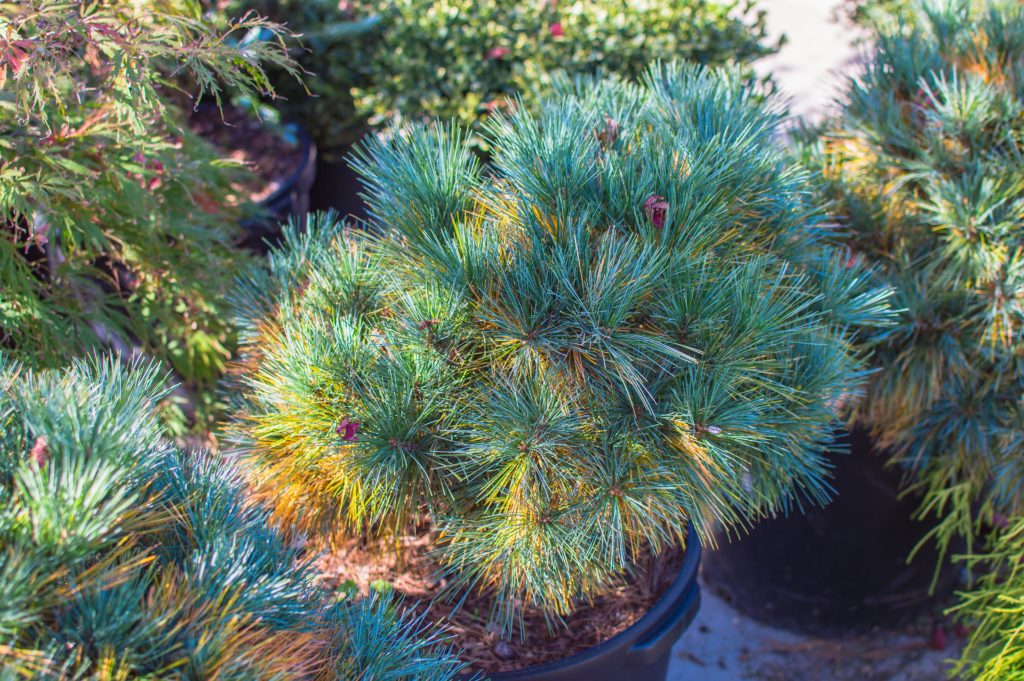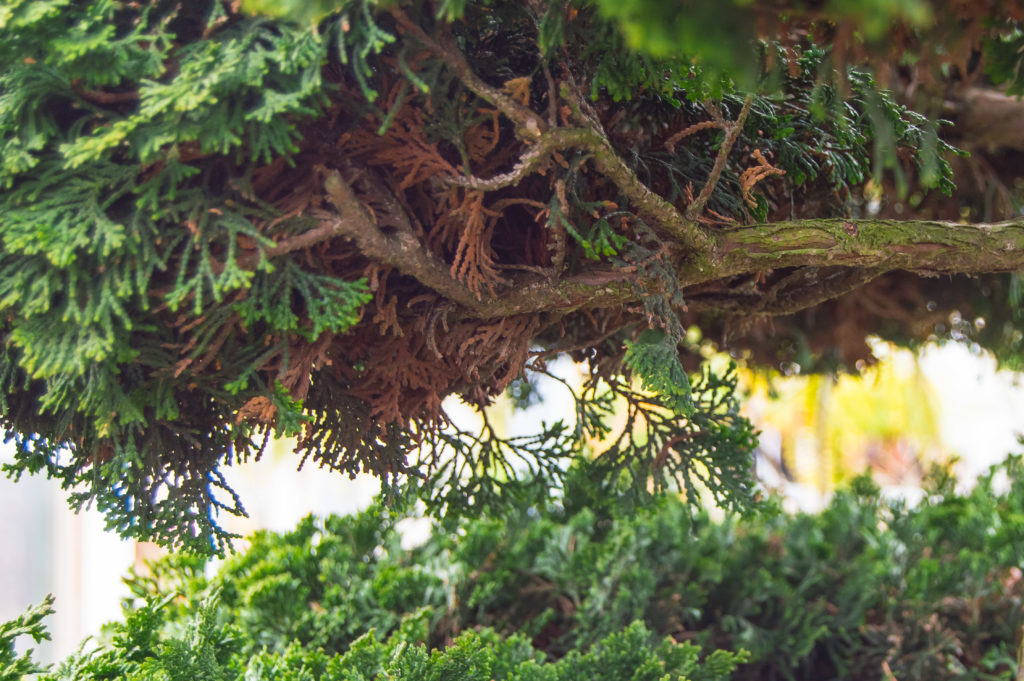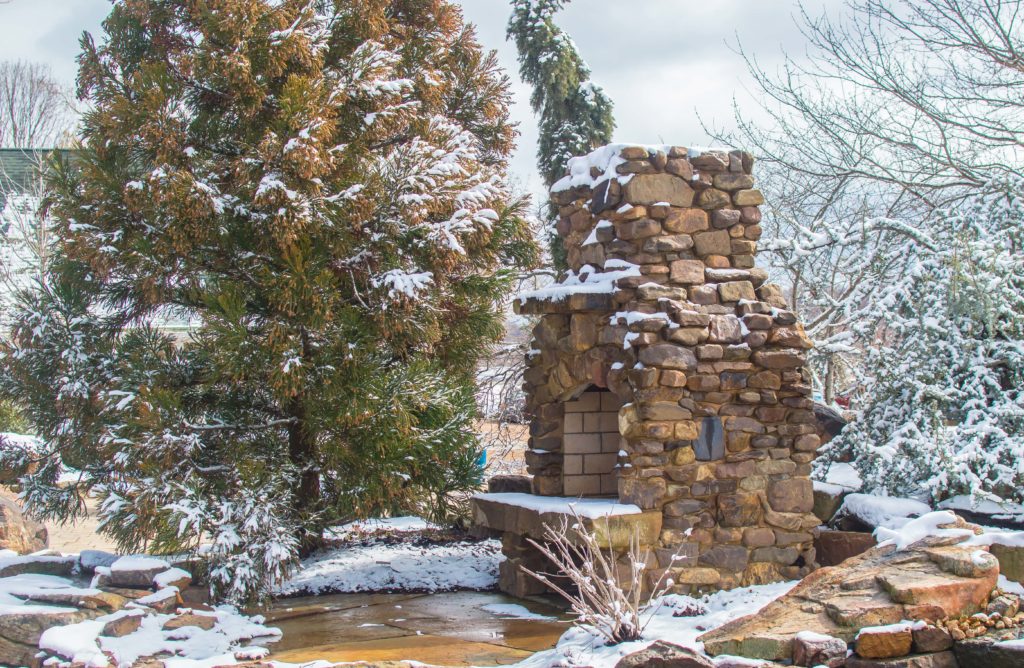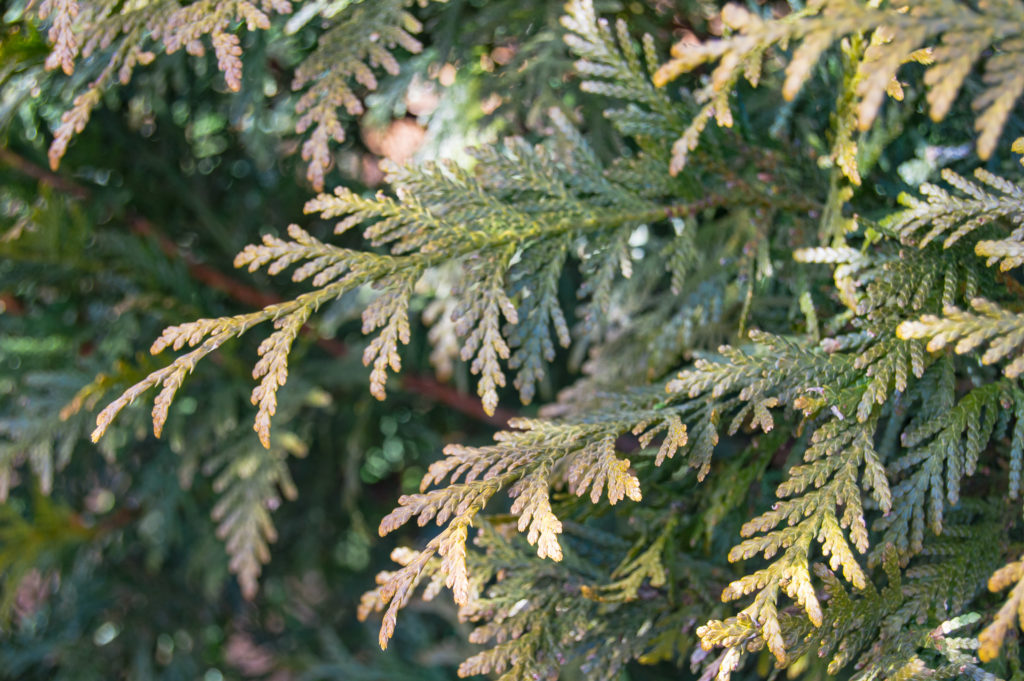Updated October 2023
Fall color is hitting its stride! Everyone is used to deciduous trees like maples, oaks, dogwoods, and ginkgos, changing color, however, when evergreens start to look different, people get concerned. While there are times that color change in evergreens can point to declining health in these types of plants, during the fall and even into the winter, it is a natural occurrence called shedding. This occurs as evergreens are naturally replacing old needles. Fall shedding is more prevalent in evergreen that are newly planted or transplanted, especially in when installation has occurred after May. One thing to remember with your newly planted evergreens is to refrain from fertilizing them until they have had at least one growing season and should not be fertilized late in the fall as new growth can get frost bit.
Needle drop usually occurs from the interior of the plant. The interior of the plant is going to be directly coming from the trunk and from the branches of the plant. If there are needles or foliage that are more external and on the outer layer that are yellowing and dropping, it is more than likely an overwatering issues. If the foliage on the exterior of the plant are browning, drought stress is the more likely culprit. Needle drop and shedding usually result in a heavier flush of new growth in the spring time.
Conifers
The urban forestry specialist for the Oregon State University Extension Service notes that conifers (cone-producing evergreens) “shed the oldest needles every year. People think they’re not in good health. But in reality they’re just going through the normal cycle.” Some conifers even lose all of their needles for the winter, just like deciduous trees dropping all of their leaves. These tree include dawn redwoods (Metasequoia glyptostroboides), western larch (Larix occidentalis), and bald cypress (Taxodium distichum). This is a completely normal occurrence. Pines will drop needles as well (see the below picture of our Blue Shag Pines that we have here at the nursery).
Conifers are not the only evergreens that undergo natural shedding. Arborvitaes, junipers, hemlocks, cryptomerias, chamaecyparis, and spruces also undergo foliage shedding. The Iowa State University Extension and Outreach notes that “seasonal needle drop on most evergreens occurs in fall.” Color on shedding foliage varies for each different type of plant. Pines are going to have a yellow-brownish shed. White pines are going to have more yellow color in the shedding needles.

Chamaecyparis
Chamaecyparis (or false cypresses) shed through the year, including during the fall months. The fan-like foliage turns reddish-brown and can be easily cleaned out by fluffing out the foliage by hand. Heavier shedding in the spring can occur after dry winters, which is also referred to as winter burn. Interior shedding is more noticeable on varieties like the Chamaecyparis Nootkatensis (or Alaskan Cedar). Sub-varieties of this chamaecyparis also produce seedling cones in mid-to-late September. The USDA fact sheet on these trees reports that these cones will “shed during dry periods in the fall and early winter” and “empty cones remain on trees for one year or more.”

Cryptomerias
Cryptomerias will have browning branches around the interior, main trunk and off of the larger branches. These branches will turn brown. Cryptomerias usually bronze a bit during the winter time as well. This occurs on all branches, interior or exterior. Not to worry, the branches will green back up in the spring. The Forest Service Department of Agriculture Cryptomeria fact sheet notates that Yoshino Cryptomerias (check out more info on ours here!) are less likely to bronze during the winter months.

Arborvitaes
Similar to cryptomerias, arborvitaes shed branchlets from the interior in an orangey-brown color (The Morton Arboretum). They will also bronze on the outside during winter months. Interior foliage, or branchlets, during the winter usually maintains its green color during winter bronzing. This is seen more in Green Giant Arborvitaes throughout the St. Louis and St. Charles areas. When there has been stress on the plant in the summer and fall, there can be an increase in shedding.

Junipers
Juniper shedding will be yellow to brown in color. More blue-toned juniper will have a more yellow color to the shedding foliage as the greener junipers shedding will be more brown. Less shedding will be seen “if the previous growing season has been favorable for growth, i.e. moderate temperatures, good insect control, and good soil moisture”, however the shedding period may be a bit longer according to the Extension Plant Clinic at Oregon State University. This applies to both shrub form and upright junipers.
Boxwoods
Boxwoods, both rounded shrub-form and upright, are also prone to winter bronzing. According to the Missouri Botanical Garden, boxwood will exhibit characteristics “where its evergreen foliage tends to bronze (turn unattractive brownish-yellow) in harsh winters, particularly if plants are located in open areas exposed to full sun and winter winds.” This can occur if there is an early freeze in the fall or a late freeze in the spring. New growth is particularly susceptible to freeze damage. To better protect your plants, we suggest a deep soak when an untimely freeze is in the forecast. It is usually best to do this deep soak the day of (when there is an overnight freeze expected) or the day before a freeze. This will help insulate the root system of your plants. There is still chance of bronzing, however, this is mainly a cosmetic effect and will not necessarily cause permanent damage or health problems for your boxwoods.
Rhododendrons
Rhododendrons, a popular shade evergreen, can also experience shedding. Interior leaves will yellow and drop. When the summer climate has been drier, this can result in more interior leaf drop in the fall.
Broadleaf evergreens can be treated with an anti-desiccant.
Not Sure If Your Evergreen is Doing Ok? We Can Help!
Just because these evergreens shed or bronze for a certain periods of time, doesn’t mean they won’t look great in your landscape! Every plant has their natural cycle, whether they are deciduous or evergreen! If your evergreen is experiencing more shedding than what’s described here, give us a call or shoot us some pictures to info@chesterfieldvalleynursery.com !
